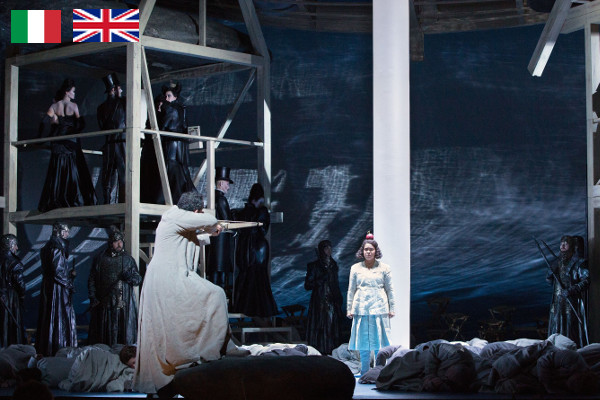Submerged and saved
by Valentina Anzani
Exciting Guillaume Tell at the Met: amazing conduction by Fabio Luisi and applauded voices
New York, November 5, 2016 - In the days of political fervor as those just passed, a work like the last of Rossini (which alternates and interweaves the political issues to those sentimental, narrating the oppressed people of Switzerland subjected to the cruel tyranny of the Austrians) ideally becomes a metaphor for a reflection on the latest political events, in which the international balances are uncertain and the decisions of a few reflect on the fate of many. Absorbed in this tense and contrasted political atmosphere, listening becomes nervous, and subject matter covered in the work becomes all the more relevant as we perceive the imminent catastrophe. As if that were not enough, the spirits in this theater were disconcerted last October 29, when one of the performances of Guillaume Tell had been interrupted and the public turned away because of a disturbing light dust cloud which had been dispersed on the orchestra: the gesture had only after revealed the innocuous act of devotion of a student who performed the last wishes of his singing teacher, splattering the ashes of him in the room of the famous opera house. Fortunately the incident had no consequences and the activity of the theater resumed regularly over the following days.
The last Rossini opera was not performed by this institution in New York since 1931, and is now on the stage of the Metropolitan Opera House in a new co-product construction with the Nederlandse Opera, signed by Pierre Audi. The directorial approach does not propose any revolutionary reading, but frames appropriately the story. It's a sober direction, offering on the microscopic level a few well-balanced and effective movements, and on the macroscopic ones very effective visions and masses movements, that also have the advantage of not only describe but also to disclose more rhetorical meanings. Audi puts the oppressed people in realistic scenes (by George Tsypin) that reconstruct the wild environment, the huts and the rocky hills on the banks of a Lake Lucerne infinitely expanding thanks to the two walls of mirrors to the sides of the stage; however, these scenes are enclosed in a larger environment: everything that happens, happens in fact just in the depths of the lake, which becomes a metaphor for the oppressive situation where there are the Swiss people literally submerged by the Austrian domination. The costumes by Andrea Schmidt-Futterer dress in virginal white the people oppressed and in black the conquerors: it is an excellent asset both to clearly distinguish the two factions, both to underline the chameleon-like change of Mathilde when passing from one to the other faction, although unfortunately often it drowns the supporting cast in anonymity.
Mathilde is Marina Rebeka, a soprano with a beautiful, smooth and warm timbre throughout the range. She demonstrates a flawless emission control from the lower notes and her pasty tones blooms even in the climbs. The simplicity with which she sings is disarming: with her delicate yarns and elegant agility, she portrays perfectly the sensitive soul of the Austrian princess who sided with the submissive people. The other female voices (Maria Zifchak, the eponymous hero's wife and Janai Brugger, en travesti as Jemmy's son) are appreciated for quality and temper. Similarly, only praise on the male side: the tenor Bryan Hymel juggles brilliantly in the very high and inaccessible part of Arnold; John Relyea, with his dark and firm timbre, is best suited to give voice to the ruthless Gesler (and the public appreciates it fervently); the eponymous hero was Gerald Finley, who played with a magnetic personality, naturally portraying with the same intensity both the revolutionary temperament and the intimate harrowing reflections. Also good yield of hieratic Kwangchul Youn who was the spiritual guide Melcthal.
Very well cared even the ballets, which play a fundamental role in the Grand opéra, and which here, choreographed by Kim Brandstrup, are an appreciable element of quality and communicative intensity, especially in the third act, when the extent of humiliation suffered by common people oppressed is elegantly suggested - only suggested precisely, without adding unwanted vulgar or provocative smear - by sadists references in the translucent black fabrics of the clothes accompanied by black leather and whip of the dancers / dominatrixes.
Last but not least: the masterful orchestral sound, which is very powerful up from the overture, which lives and beats like a narrative itself, applauded not only for its reputation, but also because the conduction by Fabio Luisi is impeccable, with tempos so wide that even insinuate overwhelming Wagnerian allusions.



